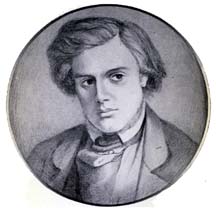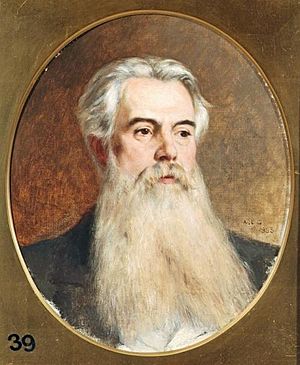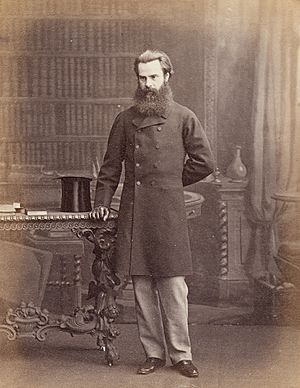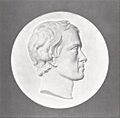Thomas Woolner facts for kids
Quick facts for kids
Thomas Woolner
|
|
|---|---|

Thomas Woolner by Dante Gabriel Rossetti, 1852
|
|
| Born |
Thomas Woolner
17 December 1825 Hadleigh, Suffolk, England
|
| Died | 7 October 1892 (aged 66) London, England
|
| Education | Apprentice to William Behnes |
| Known for | Sculpture, illustration, and poetry |
|
Notable work
|
Civilization, Virgilia |
| Movement | Pre-Raphaelite Brotherhood |
| Spouse(s) | Alice Gertrude Waugh (m. 1864) |
Thomas Woolner RA (born December 17, 1825 – died October 7, 1892) was an English sculptor and poet. He was one of the artists who helped start the Pre-Raphaelite Brotherhood. This was an important art group. He was the only sculptor among its first members.
After helping to create this group, Woolner moved to Australia for a while. He later came back to Britain. He became a very successful sculptor. He made many important public artworks. He also created memorials, tomb sculptures, and story-telling reliefs. He talked with many famous people of his time. He also found success as a poet and an art dealer. One of his well-known portrait medallions is of William Wordsworth. It is in St Oswald's Grasmere church.
Contents
Becoming a Sculptor and Artist
Thomas Woolner was born in Hadleigh, Suffolk. He learned his skills from the sculptor William Behnes. Woolner started showing his art at the Royal Academy in 1843. He became good friends with Dante Gabriel Rossetti. Rossetti then asked him to join the Pre-Raphaelite Brotherhood.
Woolner was very active when the group first started in 1848. He believed that sculpture needed to be more realistic and lively. His love for classical art sometimes clashed with the group's interest in medieval art. However, his focus on observing nature closely matched their goals.
His sculptures from this early period show great attention to detail. He became known for his strong portrait busts and medallions. But at first, he found it hard to earn enough money from his art.
Journey to Australia and Return
In 1852, Woolner had to move to Australia. This trip inspired the famous painting The Last of England by Ford Madox Brown. After just one year, Woolner returned to Britain. He quickly became successful as both a sculptor and an art dealer.
His time in Australia helped him get art jobs there and in other places. He made statues of important British figures. These included Captain Cook and Sir Stamford Raffles. His bronze statue of John Robert Godley in Christchurch, New Zealand, was damaged in an earthquake in 2011. It was later fixed and put back up in 2015.
Friendships and Controversies
Woolner became a close friend of Francis Turner Palgrave. They lived together for a time. Both were known for having strong personalities. Henry Adams wrote about them, saying Woolner had a "rough" personality. He said Woolner had to try very hard to be polite.
Woolner designed the front page image of a piping youth for Palgrave's famous poetry book, the Golden Treasury (1861). There was a small scandal in 1862. Palgrave was asked to write a guide for the 1862 International Exhibition. In it, he praised Woolner but criticized other sculptors, especially Woolner's main rival Carlo Marochetti. A writer named Jacob Omnium pointed out that Palgrave and Woolner lived together. William Holman Hunt wrote a letter supporting Woolner. But Palgrave had to remove his guide.
Major Art Projects
Woolner's biggest art job was for the Manchester Assize Courts. This building was constructed in Manchester from 1859 to 1864. Woolner created many statues of lawgivers and rulers. These were part of the building's design. The most impressive was a giant sculpture of Moses. It was placed on top of the building, above the entrance. There were also figures representing Justice and Mercy. Inside, he made a relief sculpture showing the Judgment of Solomon. The building was bombed during World War II. Some of the sculptures were saved. They were used in the new building that replaced it.
Woolner mostly earned money by making statues of famous men. But his most personal sculptures were what he called "ideal" groups. These included Civilization (1867) and Virgilia bewailing the absence of Coriolanus (1871). These works showed his effort to make stone seem alive. He also made many relief sculptures for memorials. His reliefs showing scenes from the Iliad were copied many times. These were made to honor the classical knowledge of William Gladstone.
Woolner was chosen to join the Royal Academy in 1875. He taught sculpture there from 1877 to 1879.
Thomas Woolner's Family Life
On September 6, 1864, Thomas Woolner married Alice Gertrude Waugh. They had six children together. They had four daughters and two sons. His oldest child, Amy, later wrote a book about her father's life.
His two sons, Hugh (born 1866) and Geoffrey (born 1867), went to Marlborough College. Sadly, Geoffrey died there at age 14. Hugh became a stockbroker.
Woolner died suddenly from a stroke when he was 66 years old. He was buried in St Mary’s churchyard in Hendon. His grave has a sculptor’s mallet and tools carved into its edge. Sir Stamford Raffles, whose statue Woolner sculpted, is buried inside the same church. Woolner's wife Alice died in 1912. Their son, Hugh, was traveling back to New York from her funeral. He was on the RMS Titanic and survived when the ship sank.
Poetry and Other Interests

Thomas Woolner was also a poet. His early poem My Beautiful Lady is a Pre-Raphaelite work. It focuses on strong, unresolved feelings. He later made it into a longer poem, like those by Tennyson. William Michael Rossetti said that Coventry Patmore greatly praised Woolner's poems. He said they were sometimes "over-passionate" and "sculpturesque." This meant that "each stanza was a separate unit."
In the 1880s, he wrote three long story poems: Pygmalion, Silenus, and Tiresias. Pygmalion tells of a sculptor trying to make more realistic art. He fights against a group called "The Archaics." Silenus describes the love story between Silenus and the nymph Syrinx. In Tiresias, a blind wise man remembers his long life. He shows his power to understand birds and feel what all living things experience.
Woolner was good friends with many writers of his time. These included Thomas Carlyle and Alfred Tennyson. He gave Tennyson the idea for his poem "Enoch Arden".
He also wrote letters to Charles Darwin. Darwin named a part of the human ear the 'Woolnerian Tip'. He did this after seeing a feature in Woolner's sculpture Puck. Woolner had talked about this feature when Darwin was posing for a portrait. Darwin later asked for Woolner's thoughts when writing his 1872 book The Expression of the Emotions in Man and Animals.
Images for kids
-
Virgilia bewailing the absence of Coriolanus in Strawberry Hill House
-
Illustration by Holman Hunt to Woolner's "My Beautiful Lady", published in The Germ, 1850
-
Replica of a statue of Sir Stamford Raffles by Woolner, erected at the spot where he first landed at Singapore. The original statue stands at the Victoria Memorial Hall. Raffles is the founder of modern Singapore.
-
Statue of Lord Palmerston, Parliament Square, London.
-
A Celtic warrior "attacking" the dress of the woman emblematic of civilisation in Woolner's sculpture Civilization (1867), Wallington Hall, Northumberland.
See also
 In Spanish: Thomas Woolner para niños
In Spanish: Thomas Woolner para niños













